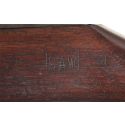M1 Garand Reload Mid Clipfreeband
The M1 Garand is a weapon featured in Battlefield 1942 and is the primary weapon issued to the USMC Engineer kit, replacing the No 4 in patch 1.5v. The difference between semi-automatic rifles and their bolt-action counterparts is their superior rate of fire, while retaining the latter's high damage profile of a two-shot kill to the chest and one-shot kill to the head. Welcome to USRIFLECAL30M1.com! If you are like me, owning an M1 Garand goes a lot deeper than just owning a firearm. It is about owning a piece of history that protected our freedoms and won a world war. Deemed the greatest single battle implement ever devised by man. (Patton), the M1 Garand is something that will consume you in the collecting of military surplus.
The semi-automatic M1 Garand was adopted as the standard issue battle rifle for the US Armed Forces in 1932 and finally started to enter service in 1936, which then led to constant refinement of the rifle. This refinement and adoption procedure precluded any work being done on a sniper version of the M1 which, as is common between wars, rated very low on the priority list for the M1. As World War II broke out for the USA, a large demand for scoped rifles and snipers developed. Because the M1 was the standard issue rifle, it was first examined for feasibility as a sniper rifle and two prototypes were approved, but because of the difficulty required to manufacture the specialized versions, they were delayed and the adoption of the M1903A4 happened in 1943 and began to be produced. This did not mean that the M1 sniper rifle ceased to exist, but instead it moved forward and authorization to produce a sniper version of the M1 was approved. Work was slow and finally the M1E7 and M1E8 were evaluated and eventually approved for production. In June of 1944 the M1E7 (renamed M1C) was adopted as the standard issue sniper rifle and replaced the M1903A4 making it “Limited Standard”. The M1E8 (renamed M1D) was adopted in September of 1944 as a “Substitute Standard”. The only difference between the C and D was the scope mounting system.
Because the M1s were loaded with stripper clips from the top of the rifles, the scopes could not be mounted in the desired location directly above the receiver. The scope mounting systems had to mount the scopes off to the left hand side of the rifle and a strap on leather cheekpiece was required to properly align the shooters eye with the scope. Over the years several different scopes were used on the M1Cs and Ds but they were all low powered when compared to today’s optics.

M1 Garand Clip Loading Tool
During World War II Springfield Armory produced 7971 M1Cs but they did not make it into the hands of US service men until the closing days of the war which prevented them from being battle tested. That all changed with the start of the Korean war, where the M1Cs were still the standard issue sniper rifle. During that time period another 4796 M1Cs were produced and during the war they proved satisfactory with a max range of about 600 yards, with fairly reliable hit percentages from 4-600 yards. Of course the 2.5 power scopes were a severe limiting factor to that max range as was the lack of military match ammo that would have been issued to snipers. The rifles continued their service until the mid 60’s and the start of the Vietnam war. During the production run in the 1950’s it was discovered that the mounting system of the M1D was superior and eliminated many of the production problems associated with the M1C and it became the more widely produced variant with 21,380 of them being built. The M1C also became the USMC standard issue sniper rifle in 1951/2 but with a different scope as the USMC performed an extensive evaluation process to locate the best scope on the market. The scope they adopted was known as the Model 4XD (a 4x Scope produced by Stith-Kollmorgen) but this rifle combination, sometimes known as the MC 52, did not see much combat use during Korea and limited use during the early years of the Vietnam war.
M1 Garand Clips Ebay
The Vietnam war saw the end of the M1Cs and Ds as the requirement for sniper rifles changed. The Marine Corps adopted the Remington M40 and the US Army adopted the XM21 a few years later. The M21 was based on the M14 which was basically a M1 shrunk down to shoot the shorter 7.62x51mm NATO cartridge instead of the .30-06. So it can be said the spirit of the M1C sniper rifles carried on for many more years in the M21.
M1 Garand Clips Cheap
We have shot a classic M1C’s and they are an acceptable performer out to about 500 yards, after which it is difficult to hit man size targets. These are classic sniper rifles, and they bring in a hefty collectors premium for good rifles, but they are a fine addition to anyone’s rifle collection and a significant part of US sniping history.
